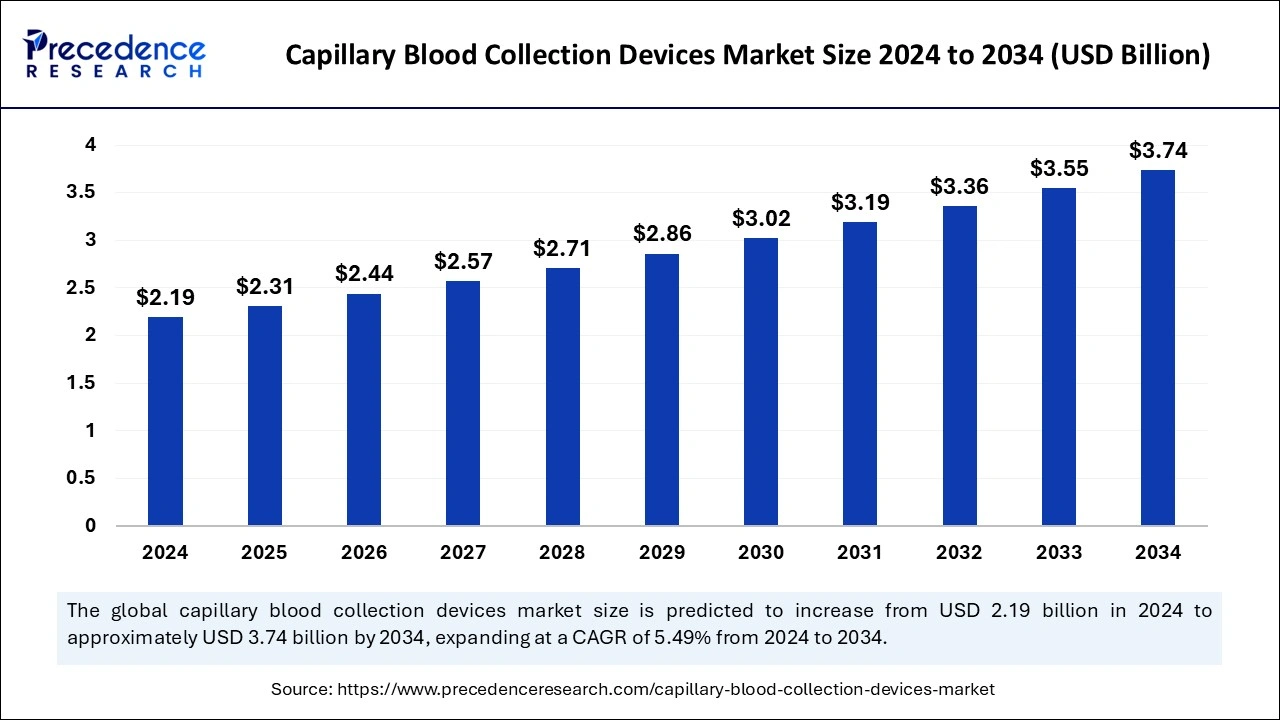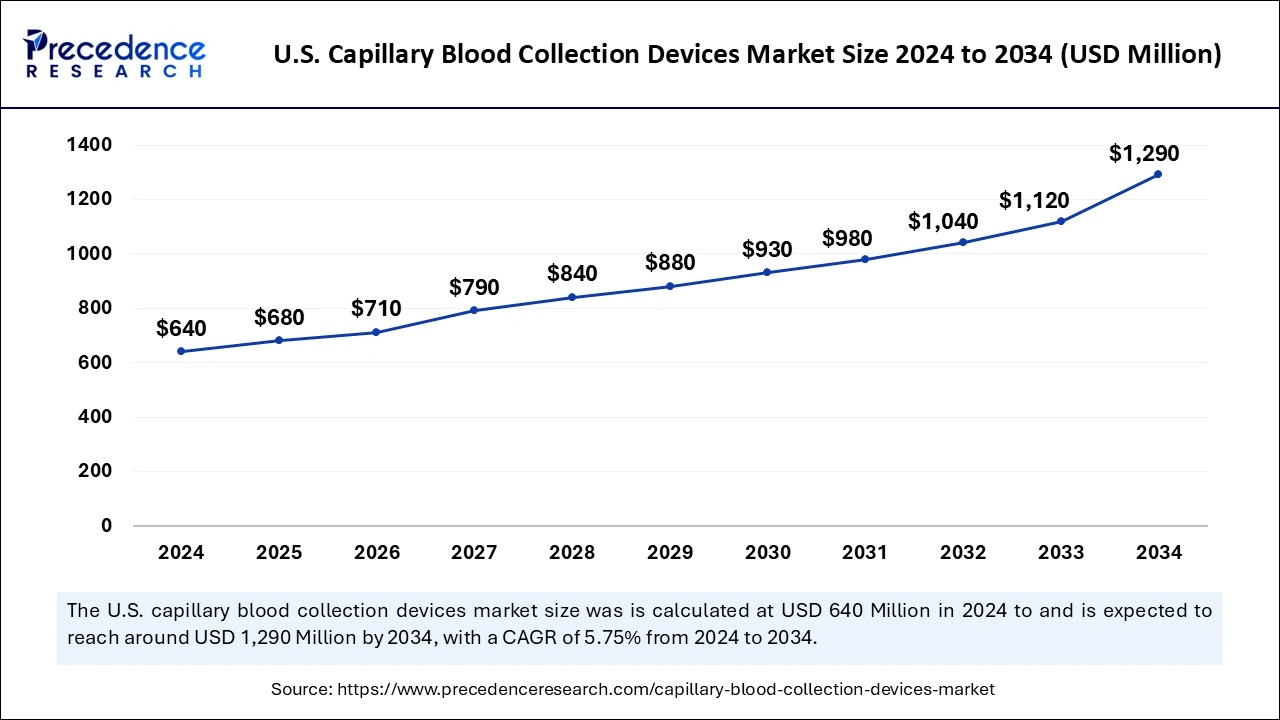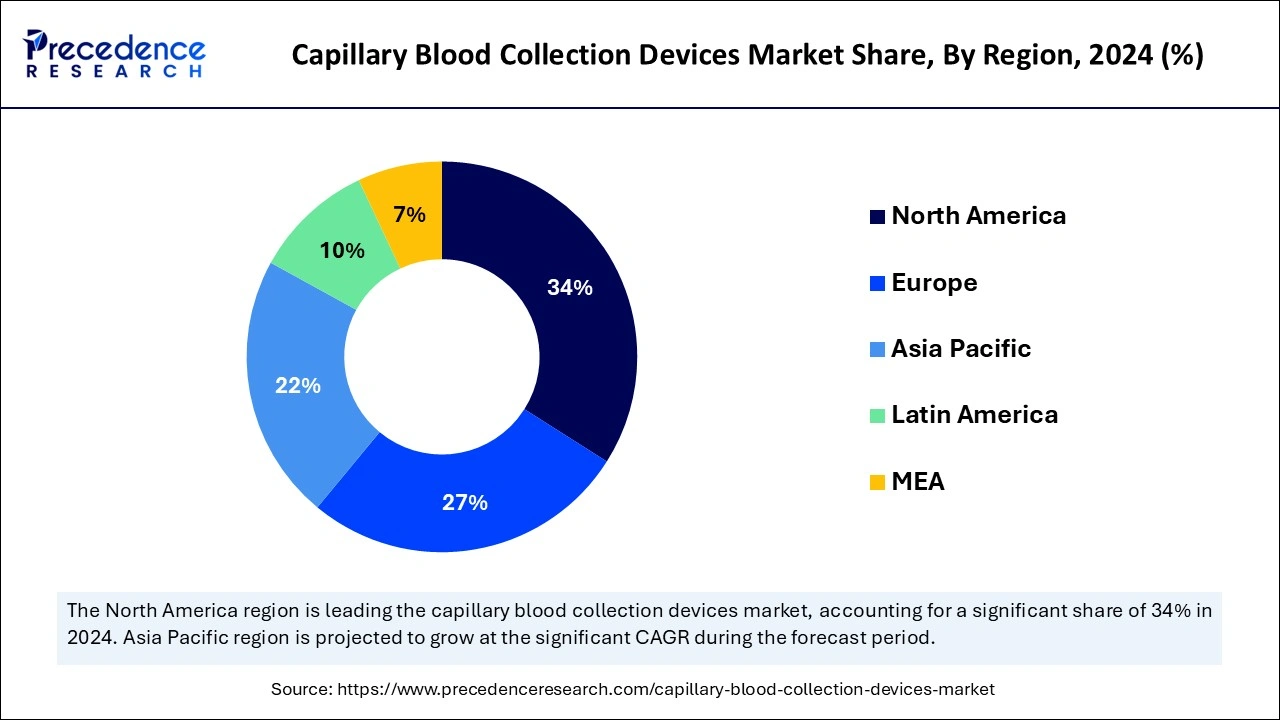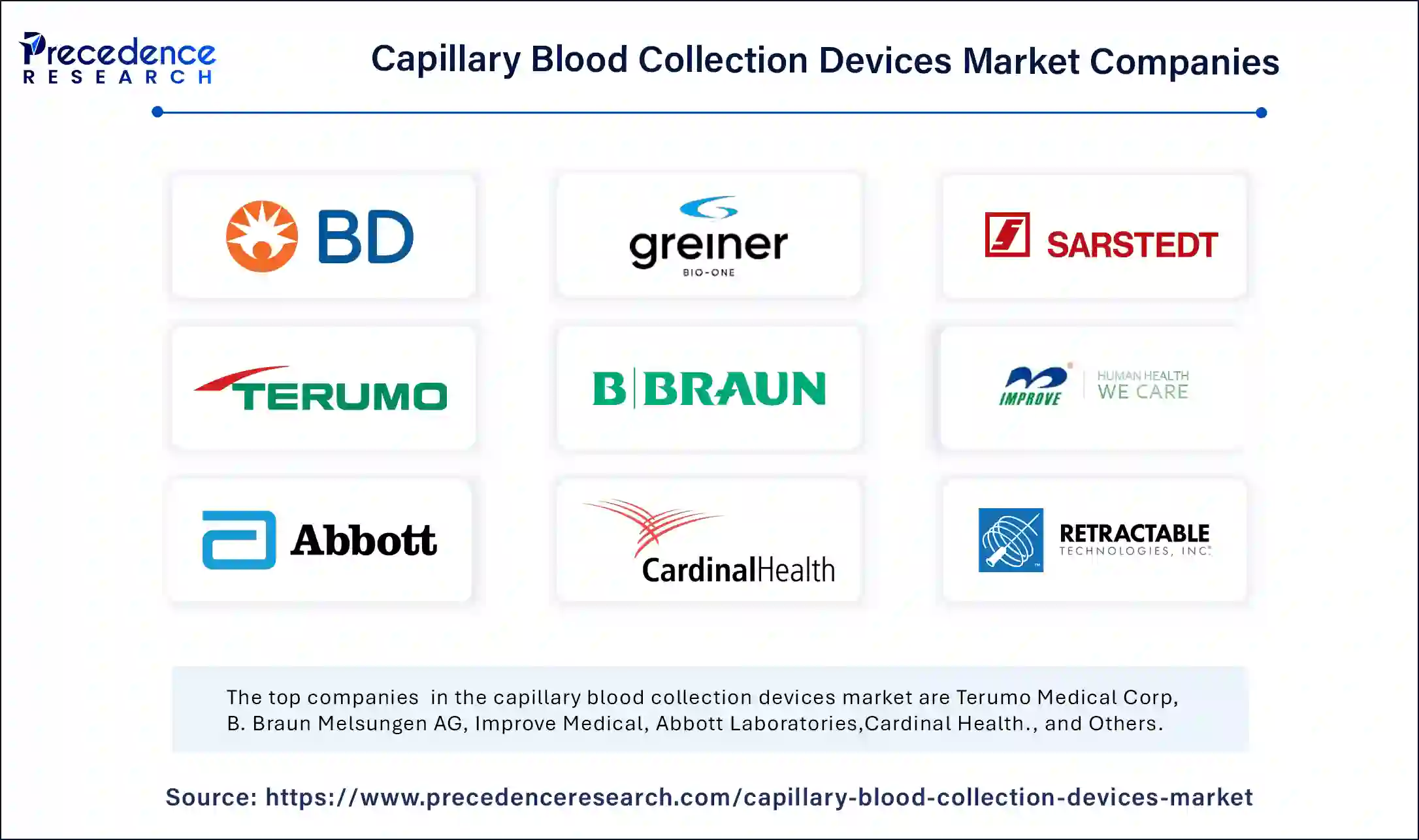April 2025
The global capillary blood collection devices market size is calculated at USD 2.31 billion in 2025 and is forecasted to reach around USD 3.74 billion by 2034, accelerating at a CAGR of 5.49% from 2025 to 2034. The North America market size surpassed USD 740 million in 2024 and is expanding at a CAGR of 5.71% during the forecast period. The market sizing and forecasts are revenue-based (USD Million/Billion), with 2024 as the base year.
The global capillary blood collection devices market size accounted for USD 2.19 billion in 2024 and is expected to exceed around USD 3.74 billion by 2034, growing at a CAGR of 5.49% from 2025 to 2034. The capillary blood collection procedures can affect the quality of samples and the accuracy of test results, the capillary blood collection devices market is growing, reflecting the urgent need for testing, and widespread standardization.

Remote self-collection of capillary blood using an upper arm device for autoantibody analysis in immune-mediated inflammatory rheumatic diseases by integration of Artificial Intelligence. Analysis and post-analysis evaluation are the most important aspects of clinical practice, new opportunities have emerged to expand the benefits of expertise further. This is a smart approach for many hardworking organizations entering the pre-analytical phase; machine learning (ML) and deep learning (DL) are being used to help classify different types of cancer, facilitate faster diagnosis, and provide the basis for clinical decision-making to achieve better outcomes.
Artificial intelligence is widely used in many areas of science and medicine, including clinical medicine. Robotic devices can guide needles and catheters into small blood vessels with little maintenance. It combines artificial intelligence with near-infrared and ultrasound imaging to perform invisible tasks such as identifying, classifying, and estimating the depth of blood vessels in surrounding tissue and then tracking their work.
The U.S. capillary blood collection devices market size was evaluated at USD 640 million in 2024 and is projected to be worth around USD 1.12 billion by 2034, growing at a CAGR of 5.75% from 2025 to 2034.

Advancements and Initiatives Propel North America
North America dominates the global market due to advances in medical discovery, diagnosis, and treatment. Healthcare companies support the market at the forefront of healthcare by developing new technologies, services, and solutions that improve healthcare for patients and medical procedures for physicians. North American healthcare companies must be able to offer healthcare organizations a robust, reliable portfolio of advanced technologies and materials.
Capillary blood collection devices, which are made from connected materials, can make care more efficient and effective. Government initiatives are helping to support the growth of the capillary blood collection device market, such as J-PAL North America’s Healthcare Delivery Initiative (HCDI) for the United States, a randomized trial supporting the country’s healthcare strategy plans. A better country that is effective and honest has led to the development of the capillary blood collection devices market.

Rapid Growth Amid Rising Healthcare Demand and Aging Population in Asia Pacific. Asia Pacific will host the fastest-growing capillary blood collection devices market during the forecast period with the increasing medical demand in the region. Healthcare companies are strengthening healthcare services through new services, education, and digitalization. Support better service integration and re-enhance patient care. The prevalence of chronic diseases is increasing in Asia Pacific. Chronic diseases lead to the need for blood tests. The elderly are aging, and the demand for blood tests is increasing; for example, Japan is aging rapidly, and the purpose of the test is to measure the blood sugar function of the increase in blood sugar level after eating sugar.
The capillary blood collection devices market is growing rapidly because capillary blood collection is a medical procedure designed to aid in the diagnosis, management, and treatment of patients and is increasingly used worldwide, in part due to the increasing number of medical devices, treatments, and clinical trial growth. It is also frequently used to obtain small amounts of blood for laboratory testing, as it can reduce pain. The capillary blood test system can reflect the quality and accuracy of the test results and indicate that urgent and detailed information is needed.
Capillary blood sampling, where blood is collected by pricking the finger, ankle, or ear, is increasingly used in medicine. It has several advantages over phlebotomy: It is less invasive, requires less blood, and can be performed quickly and easily. This technology is becoming popular, especially with the widespread use of point-of-care testing (POCT), which is becoming the fastest-growing area of medicine. Capillary blood collection has several advantages over venous blood collection. It is easy to draw blood from a vein, but it can be difficult, especially for babies.
| Report Coverage | Details |
| Market Size by 2024 | USD 2.19 Billion |
| Market Size in 2025 | USD 2.31 Billion |
| Market Size in 2034 | USD 3.74 Billion |
| Market Growth Rate from 2025 to 2034 | CAGR of 5.49% |
| Dominating Region | North America |
| Fastest Growing Region | Asia Pacific |
| Base Year | 2024 |
| Forecast Period | 2025 to 2034 |
| Segments Covered | Product, Material, End-use, Application, and Regions. |
| Regions Covered | North America, Europe, Asia-Pacific, Latin America, and Middle East & Africa. |
Innovation in minimally invasive techniques
The capillary blood collection device market is witnessing significant growth driven by advances in minimally invasive technologies that are important in terms of pain relief and accessibility for people. Capillary blood collection offers a less invasive, less painful, and easier-to-use alternative to venous or arterial blood collection, with the added benefit of having a different body composition, such as ears, forehead, ankles, palms, and arms.
Innovations in medical phlebotomy technology have addressed needle phobia and increased patient compliance through frequent testing for effective disease monitoring and management. Additionally, the development of advanced capillary blood collection technology supports low healthcare standards, leading to new approaches to patient care.
Limitations in sample integrity and accuracy
The growth of the capillary blood collection device market is limited by challenges in model uniformity and reliability. Capillary blood tests often contain undetermined amounts of venous, arterial, and microvascular blood, as well as contamination from interstitial and intracellular fluids. Many micro-collection devices require adequate sample collection from a single puncture site, increasing the risk of contamination, hemolysis, and clotting. These factors increase the likelihood of false positives and undermine the reliability of capillary blood tests for accurate diagnosis. These limitations constitute a significant constraint on commercial expansion, especially in applications requiring high sensitivity and consistency.
MiniDraw collection system
The BD MiniDraw collection system brings significant opportunities to the capillary blood collection devices market by meeting the basic needs of the patient and the process. It has fewer side effects than venipuncture and is particularly suitable for patients with venous problems or needle phobia, while also yielding consistently good microvolume samples and reducing hemolysis rates compared to traditional methods.
Designed for use by physicians with or without phlebotomy training, MiniDraw enables increased access and convenience for blood collection in non-traditional, patient-centered environments such as retail stores and medical facilities. The MiniDraw system increases sales staff confidence by eliminating the need for specialized training and improving the convenience of healthcare testing, making it necessary for patients and providers.
The plastic segment dominated the global capillary blood collection devices market in 2024 as plastic reduces the risk of infection and prevents injury. They also have self-sealing gaskets that allow air to escape when the tube is filled. Plastic tubes are used for laboratory procedures, while plastic capillary tubes are used for blood collection and hematocrit determination. The ability to be coated with anticoagulants or coatings depending on the intended use has led to the development blood collection sector.
The glass segment is expected to grow at the fastest rate during the studied years as glass capillary tubes are widely used in laboratories to absorb and separate small liquid samples. They are often used in medicine and life sciences to collect and analyze fluids such as blood and urine. Capillary tubes reduce pressure, collect various liquid samples in the laboratory, and control concentration, molarity, and molality.
The lancet accounted for the largest capillary blood collection devices market share in 2024 as blood lancets, or simply lancets, are small medical instruments used to collect blood from a vein. It has a double-edged blade and a pointed tip. A lancet device is used to draw blood and test blood sugar (glucose). This device has two parts: a "lancet holder" that resembles a small pen and a lancet, which is a sharp tip or needle that is placed in a holder.
The micro-container tube segment will grow at a significant CAGR over the forecast period as micro-container blood tubes are designed for ease of use and to aid in the storage of capillary blood. It ensures good capillary blood collection. It provides an easy way to collect small amounts of blood for general analysis.
The whole blood tests segment dominated the global capillary blood collection devices market in 2024 as it is used to check general health and diagnose many diseases such as anemia, cancer, and leukemia. They help doctors diagnose diseases and conditions. They also help analyze the body's functioning and show treatment studies leading to the development of the market.
The plasma/ serum protein tests segment will witness the fastest growth during the forecast period as the test helps doctors make overall health decisions. Plasma protein testing is also called total protein testing. The plasma protein test is a blood test that measures the amount of protein in the blood. This lab work is often done as part of the comprehensive metabolic panel (CMP) during a physical exam.
The blood donation centers segment is expected to grow at the fastest rate in the coming year, as capillary blood collection involves accessing the skin system to access the capillary bed through the subcutaneous layer of the skin. Capillary dried blood microsampling has been used for many years in donor centers to test infants on dried blood (DBS) cards. These centers also collect capillary blood for blood lipids and blood sugar.

By Product
By Material
By End-use
By Application
By Geography
For inquiries regarding discounts, bulk purchases, or customization requests, please contact us at sales@precedenceresearch.com
No cookie-cutter, only authentic analysis – take the 1st step to become a Precedence Research client
April 2025
January 2025
August 2024
March 2024